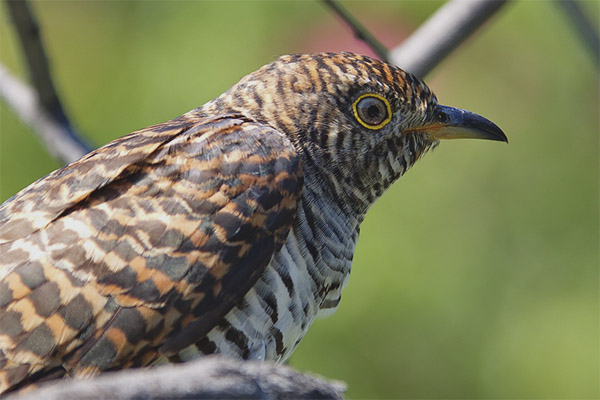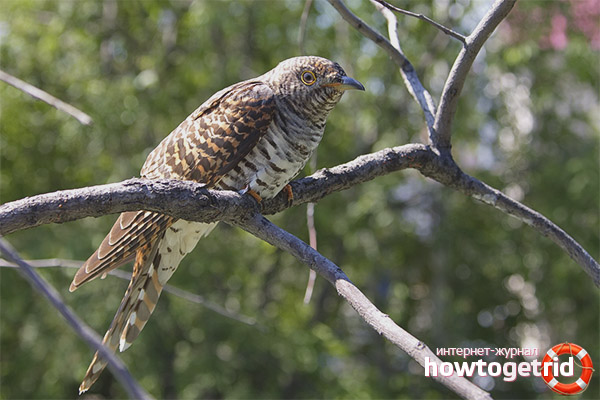The content of the article
There is hardly a person who did not hear the spelling of this bird. When spring comes or the beginning of summer, cuckoos immediately make themselves felt. Their chirping can be seen in urban parks and other areas with vegetation. Hearing the voice of a bird is not the same as observing its behavior. Today we will look at key points affecting these members of the group. Let's start.
Description
- The deaf cuckoo differs from the ordinary one not only in external data, but also in voice. Also, these birds are slightly smaller in size, they grow to a maximum of 32 cm with a body weight of 150 grams. and a wingspan of about 56 cm.
- As for the way of life and behavior in particular, when an individual is in a calm state, it does not lift the tail, but on the contrary, lowers it. When the bird starts singing, it keeps its wings in a relaxed state, the tail is still lowered.
- In terms of color features, females are only slightly different from individuals of male sex. The ocher hue of female representatives is poorly pronounced in the neck. The upper part is dark, as if gray, the color of slate. In the region of the sternum and abdominal part there are stripes. The area under the tail is yellow with a slight ocher gleam, a large number of bands are missing.
- In these birds, white feathers are present in the area of bending of the wings, while in the ordinary representatives of the family these zones are colored with variegations. Females can be red with a mottled upper part, so they visually look dark. The undertail is not one shade, but many-sided.
- In adults, the beak at the base is yellow, as are the legs with an orbital ring. The irises are brown. The young members of the family of color basically no. They are only contrasting, white with brownish. The area of the neck and chin is painted a dark tone. In the area of the crown can be observed dark spots.
Habitat
- Individuals of the discussed species of breed live in the vastness of our homeland.They are met in large numbers in the Arkhangelsk Region, on Chukotka and Kamchatka, on Sakhalin, and on the Kirov Region. Individuals live in Japan and Mongolia.
- Individuals are found in Asia, New Guinea, Australia, Karelia. There are representatives of the species in the Moscow region and the Volga region. In general, their habitat is very extensive, it is difficult to identify a specific region to which the bird is not involved.
Lifestyle
- The represented individuals prefer to live mainly in mixed and taiga forests. In rare cases, the birds in question were seen in forest-steppe, forest-tundra, and mountain crimping. The main difference between such specimens and ordinary cuckoos is that they practically do not inhabit the anthropogenic and mosaic landscapes.
- The represented individuals simply avoid open areas even during migrations. Males of this species are much less able to talk in open areas, unlike males of the common cuckoo. As for the diet, it is practically no different from the usual for us individuals.
- Among the represented individuals, parasitism is also developed. Deaf cuckoos throw their eggs mainly in the nest of chiffs.How the female of the presented species behaves at this time was not fully studied. It is worth noting that such cuckoos have very small white eggs with a red blotch.
- As a result, spring ships, tenkovki and talovki are engaged in raising chicks in such a place. The behavior of the chick is almost exactly the same as that of the common cuckoo. It is worth noting that in the first case, the young of the color is darker pharynx. The incubation period is up to 2 weeks. After that, the chicks are fed for about another 16 days. After another 2 weeks, the youngsters are already flying off the nest.
Breeding
- Do not forget that the individuals in question are nested parasites. This is a characteristic feature of almost all species that belong to the cuckoo. Often the breeding period falls on the beginning of the summer.
- Cuckoos throw their eggs to sparrows, toads, blueberries and similar birds. After only 2 weeks, the young are born. Moreover, the cuckoo chicks emit other chicks and even the eggs of adoptive parents.
- Moreover, the adults do not even understand that they are raising an alien chick. They take care of him and feed him.
The individuals represented are in some sense unique.For a long time they were considered doubles of the usual cuckoo and were not distinguished into a separate species. However, these birds do not have a close relationship. They are only similar type of reproduction and external signs. However, wintering places and diet vary widely.












To send